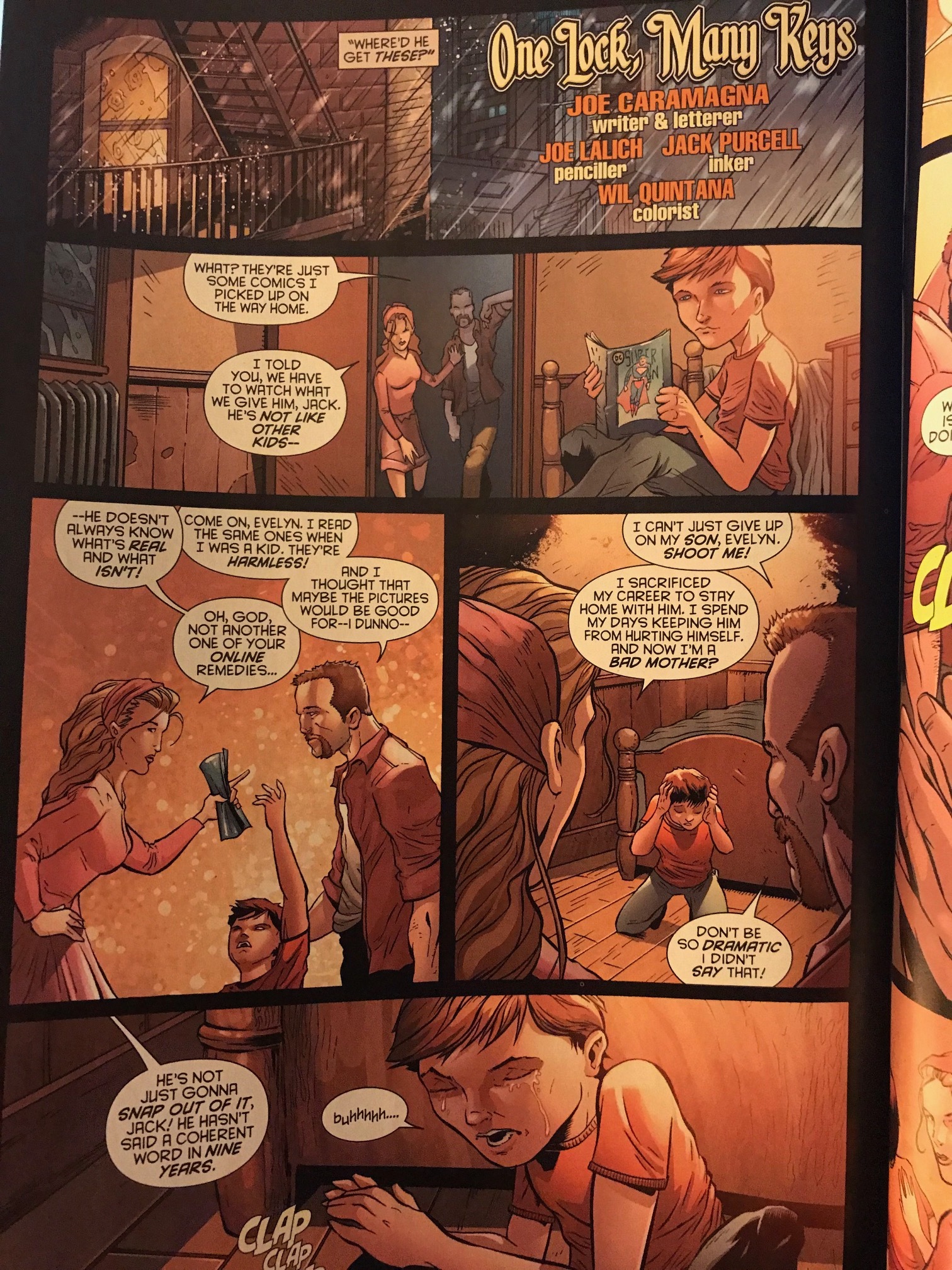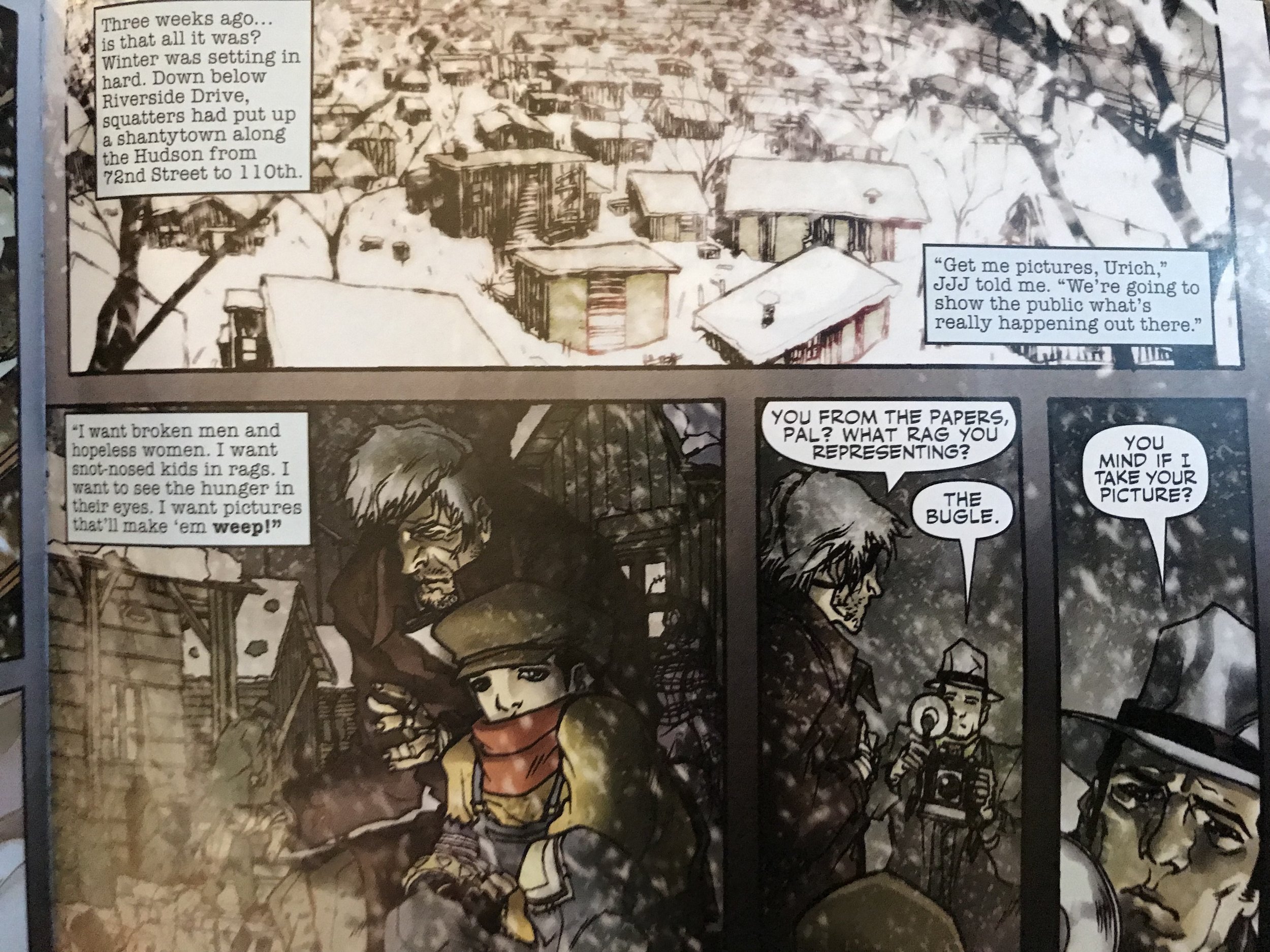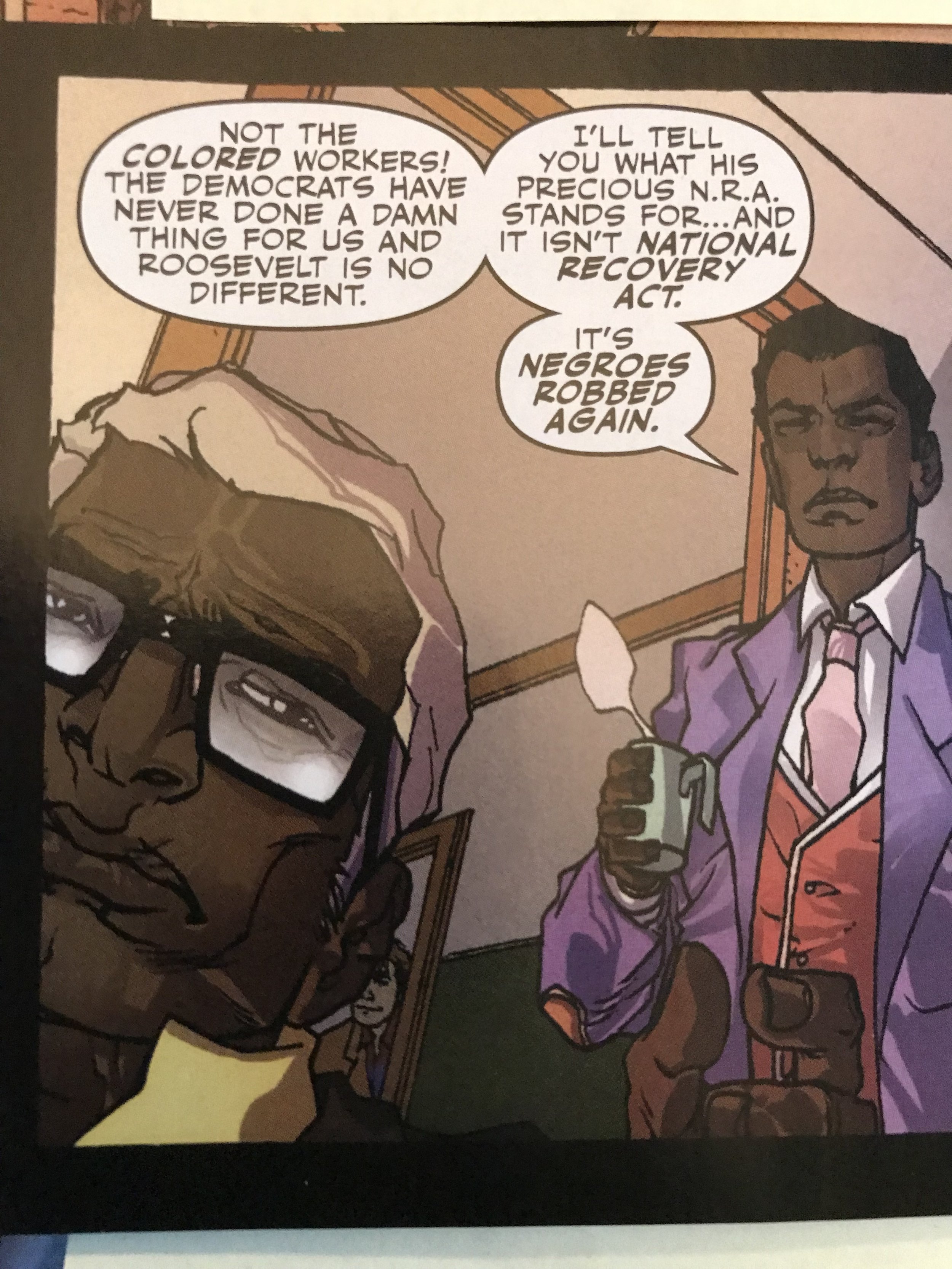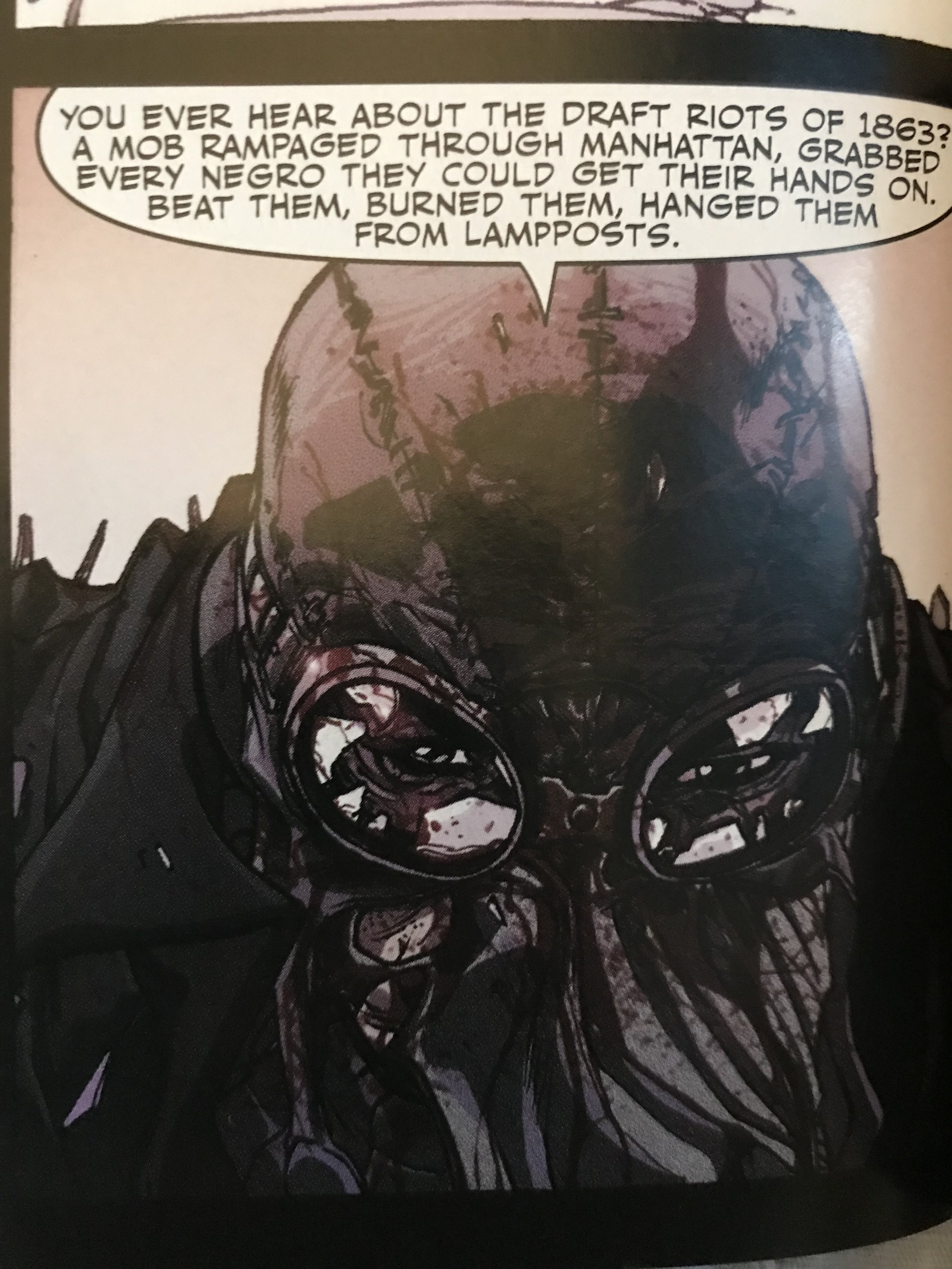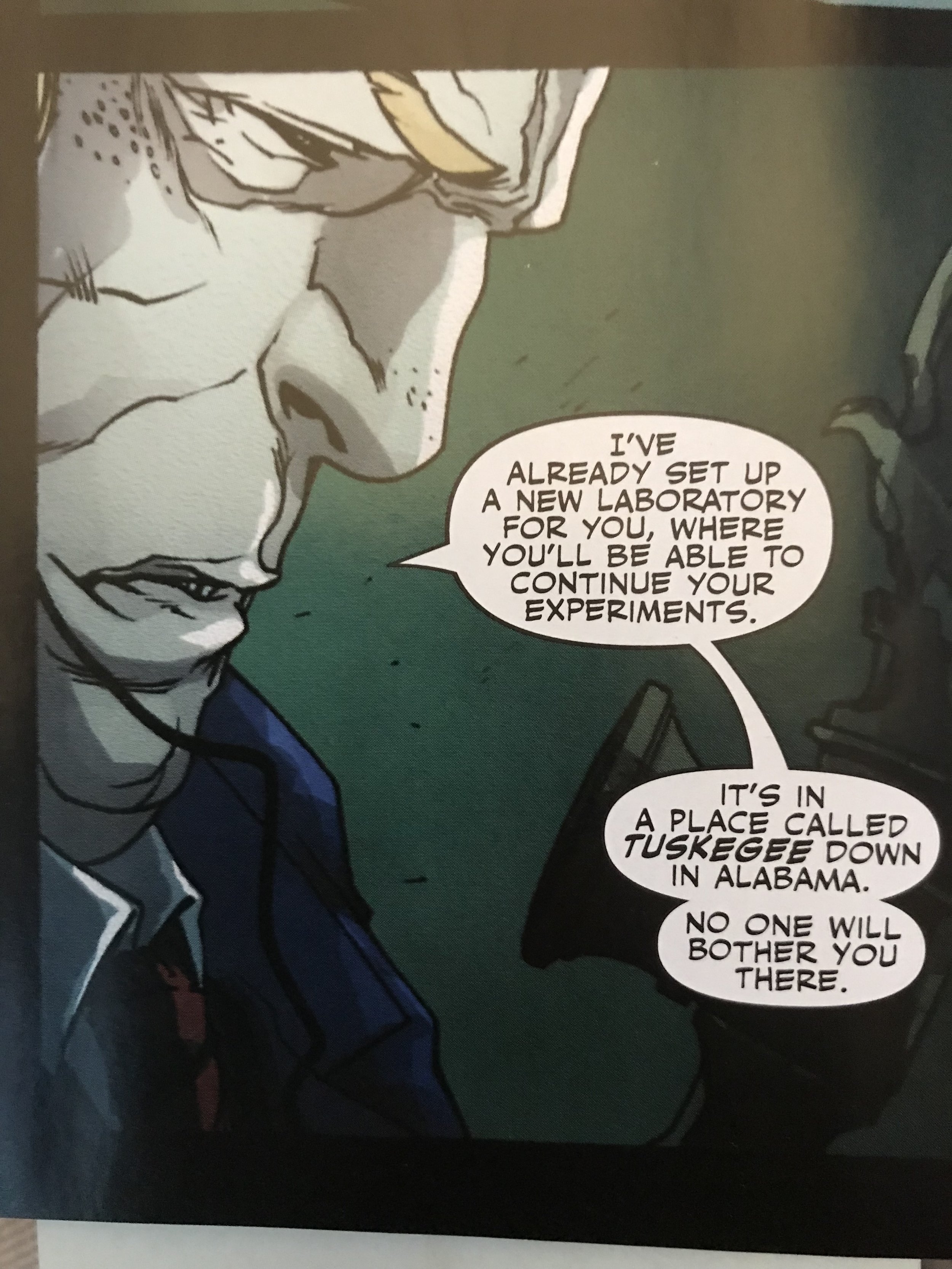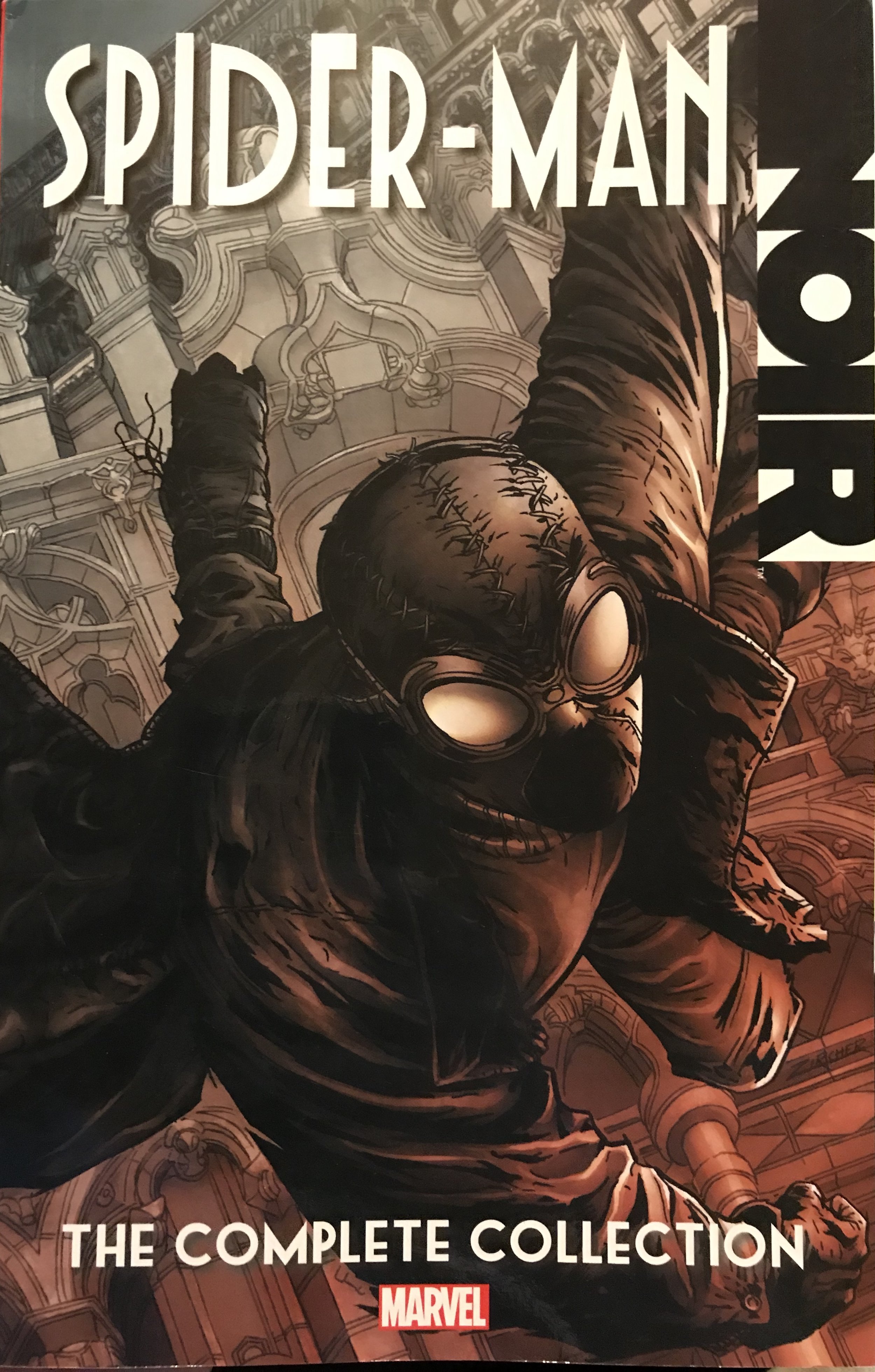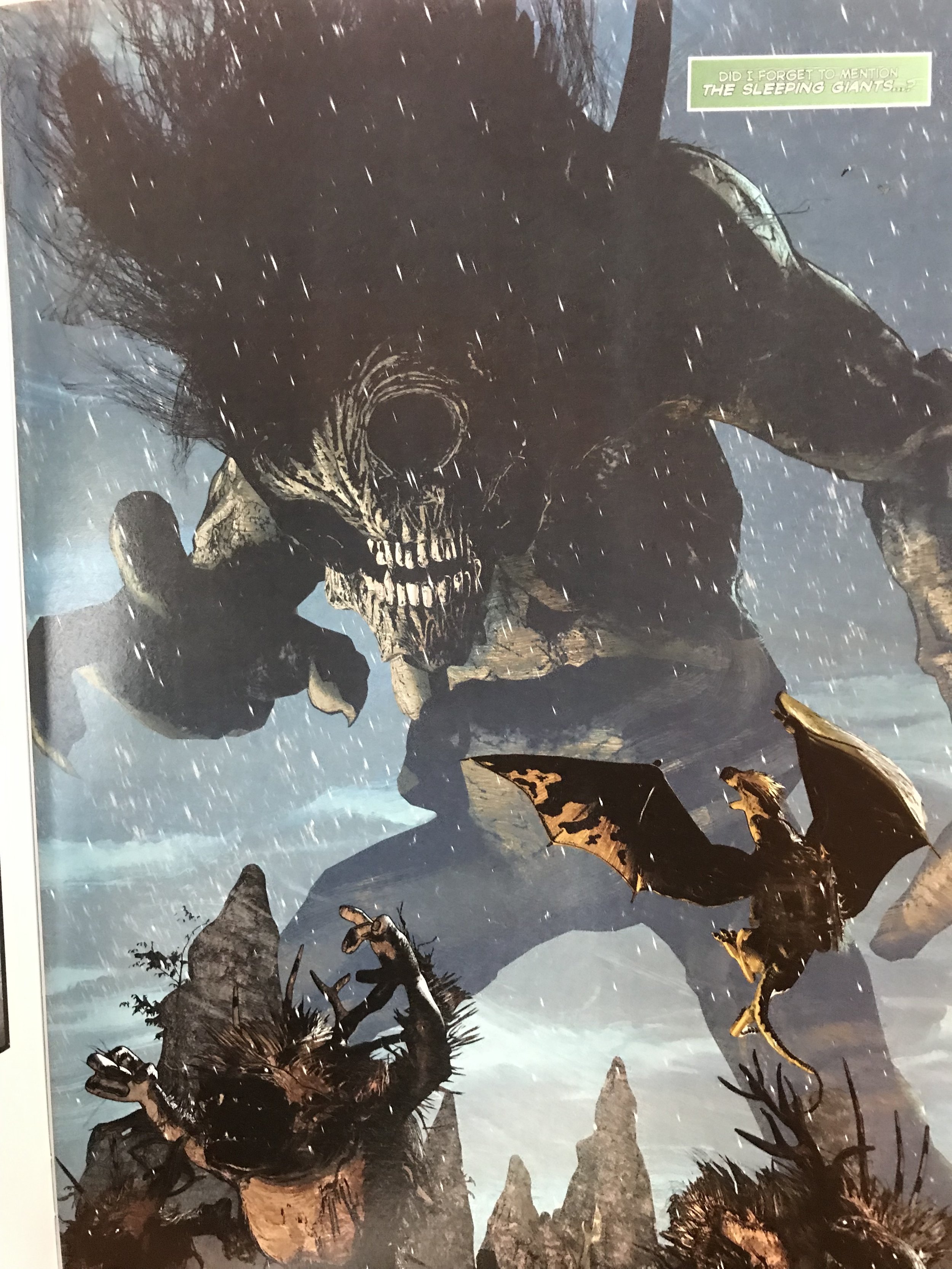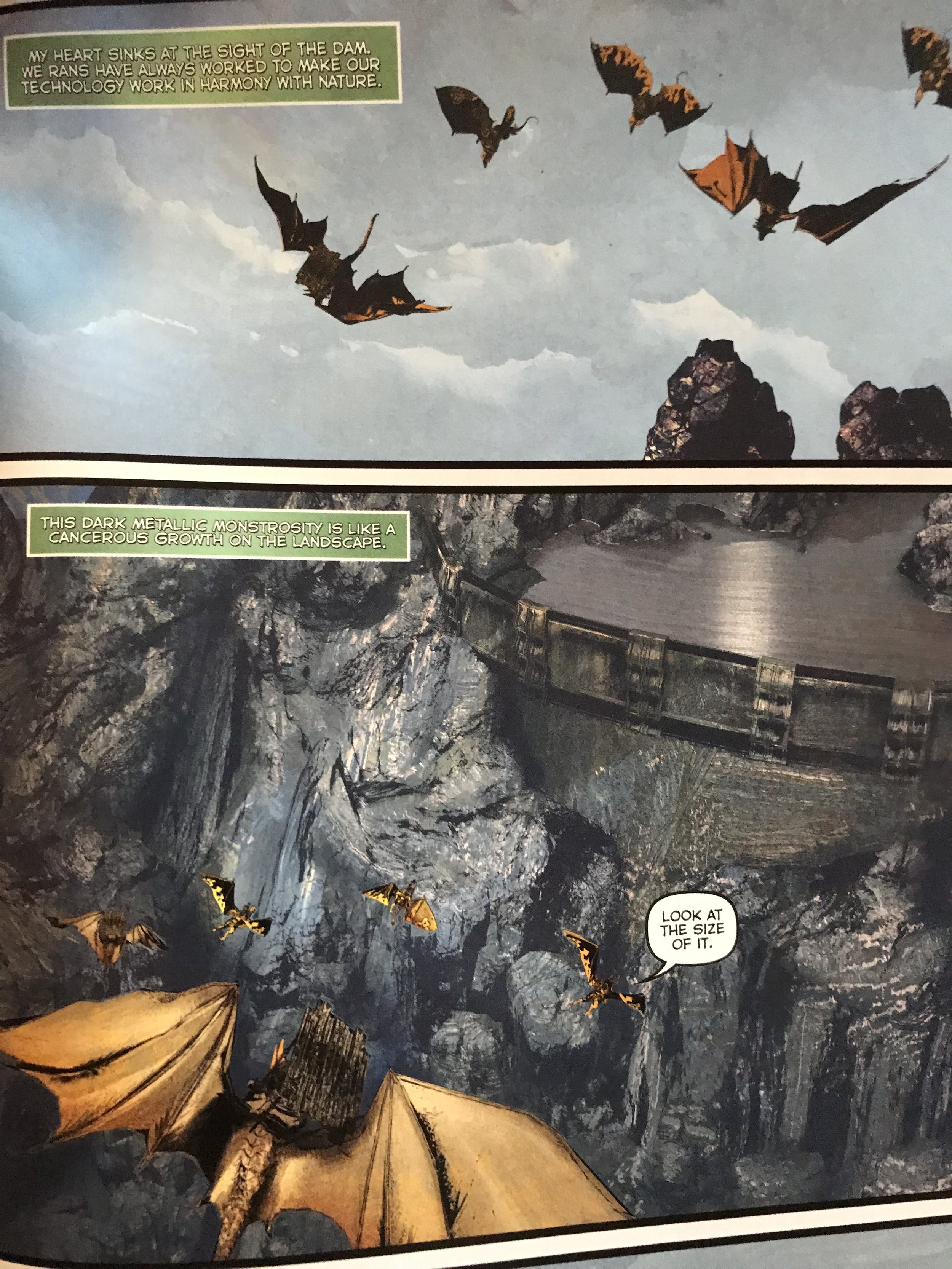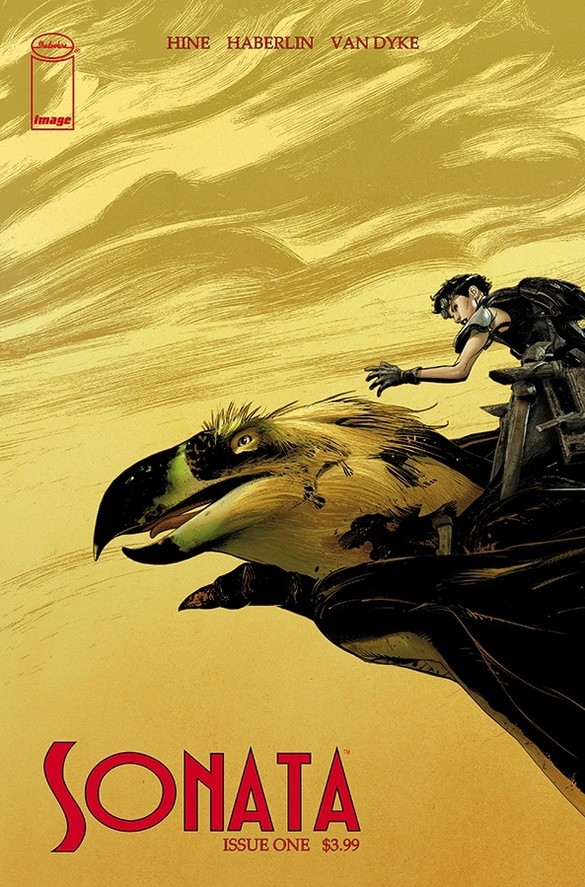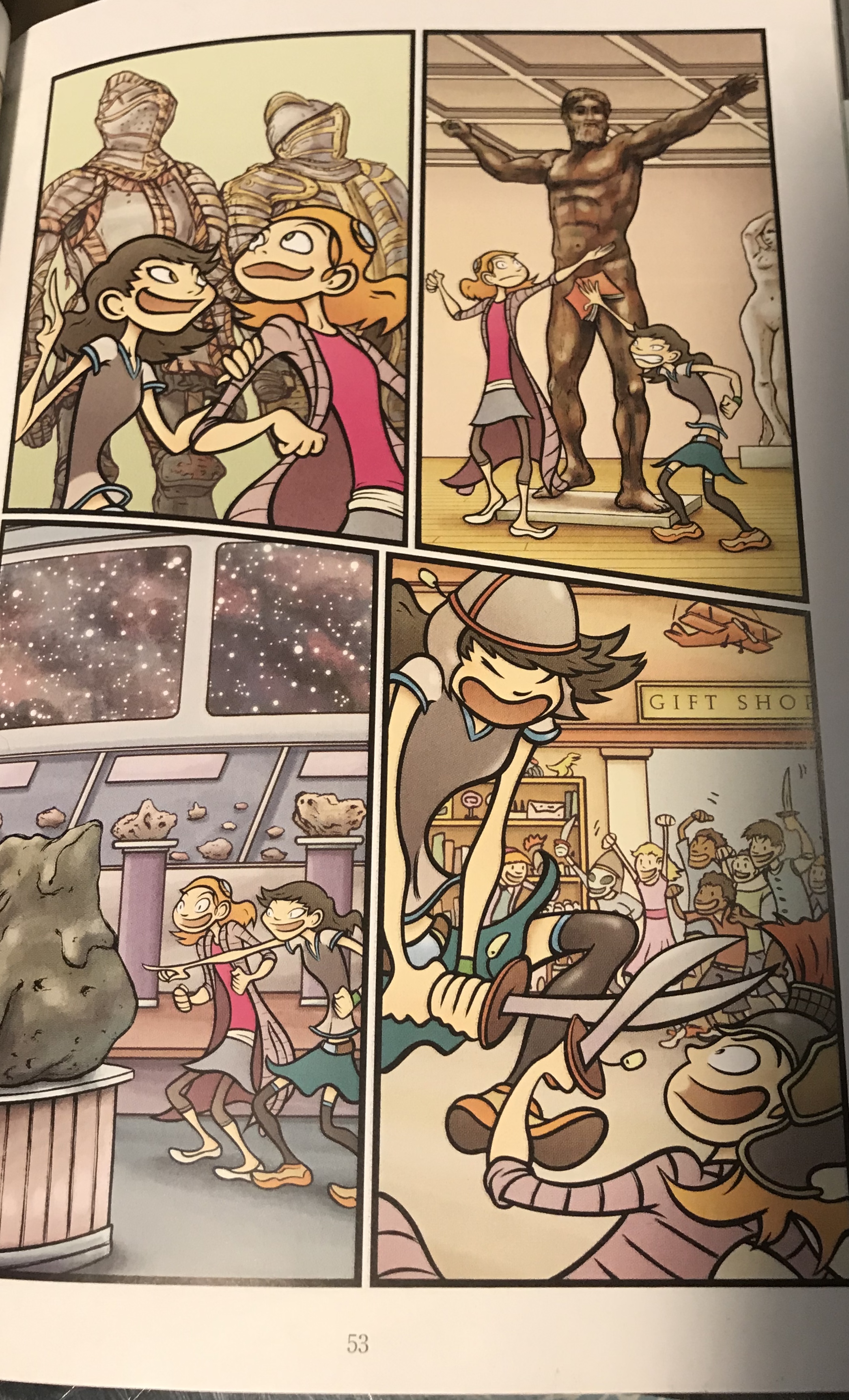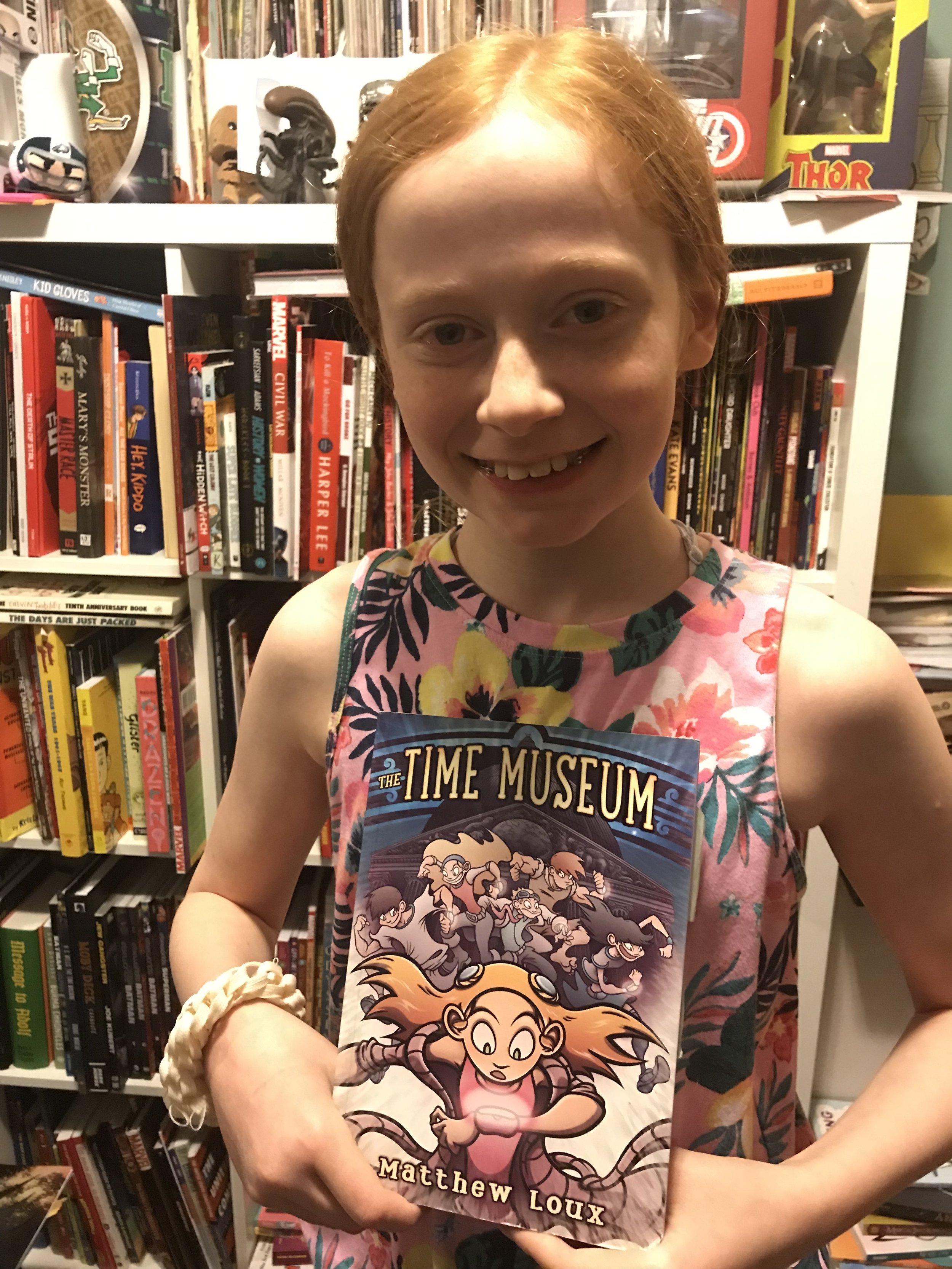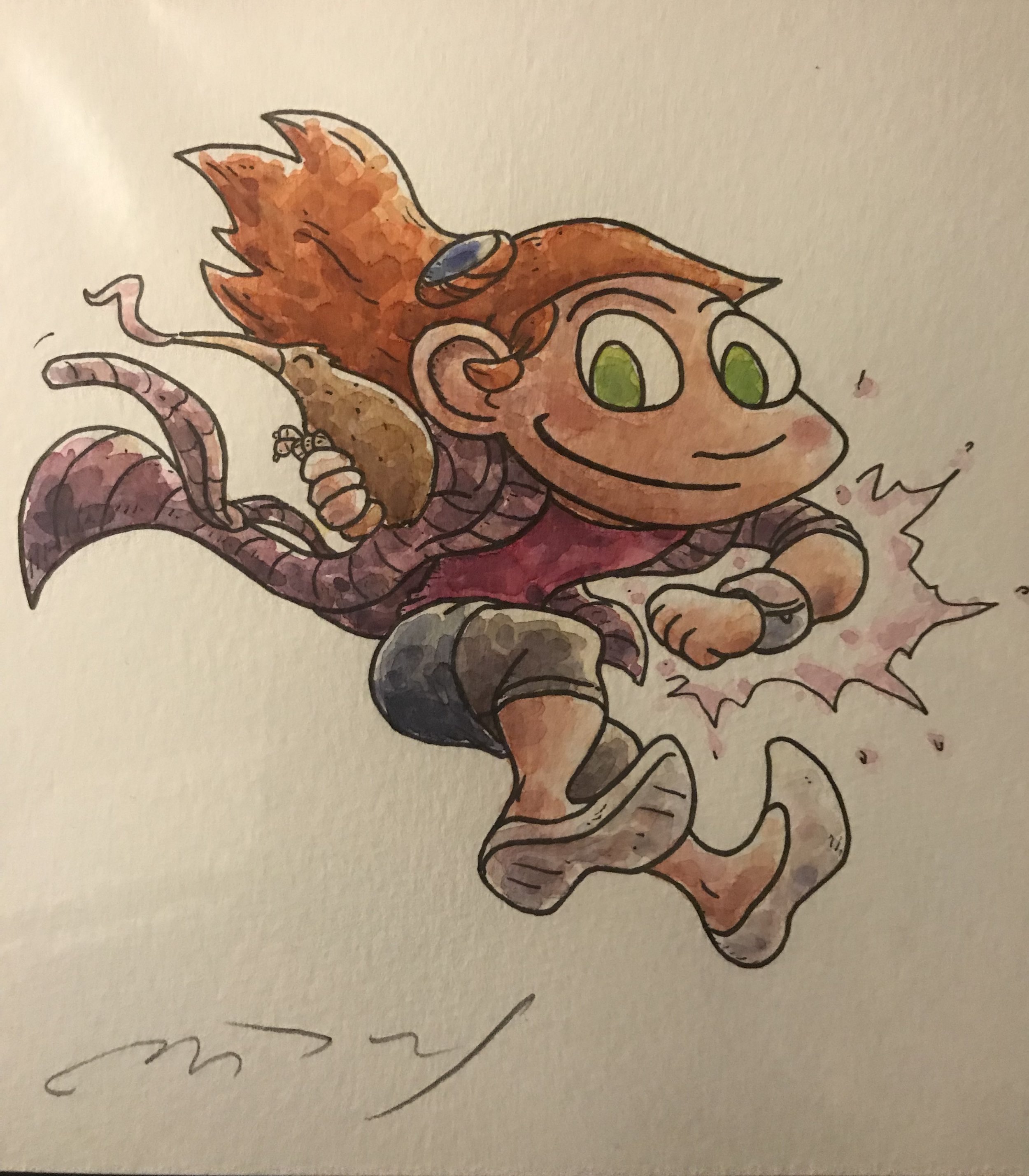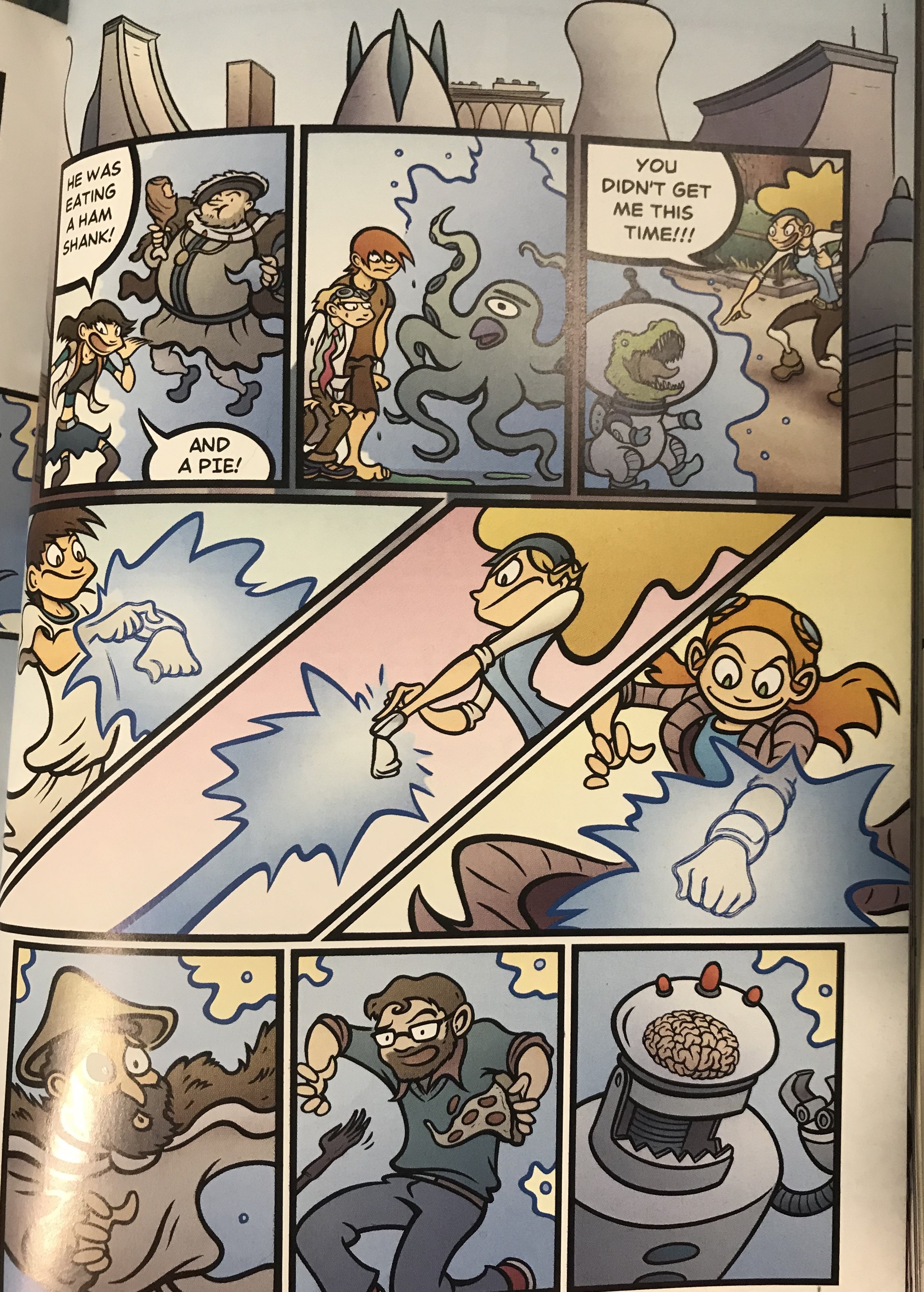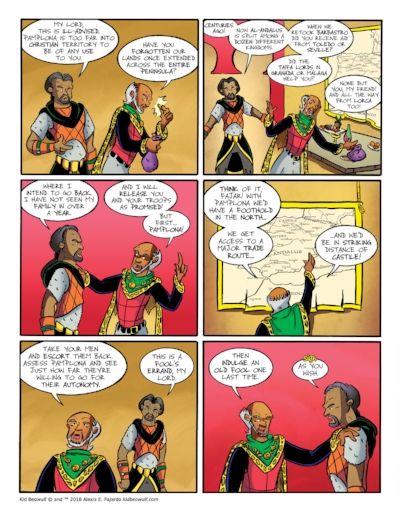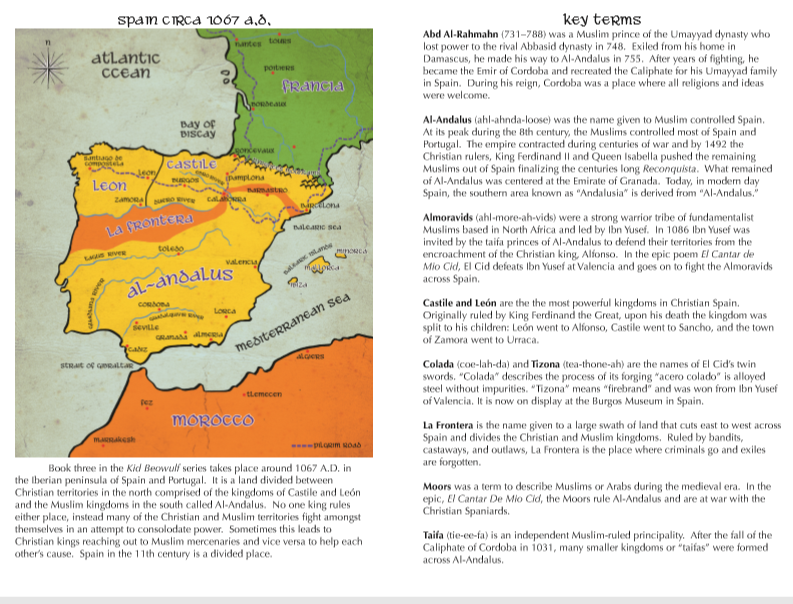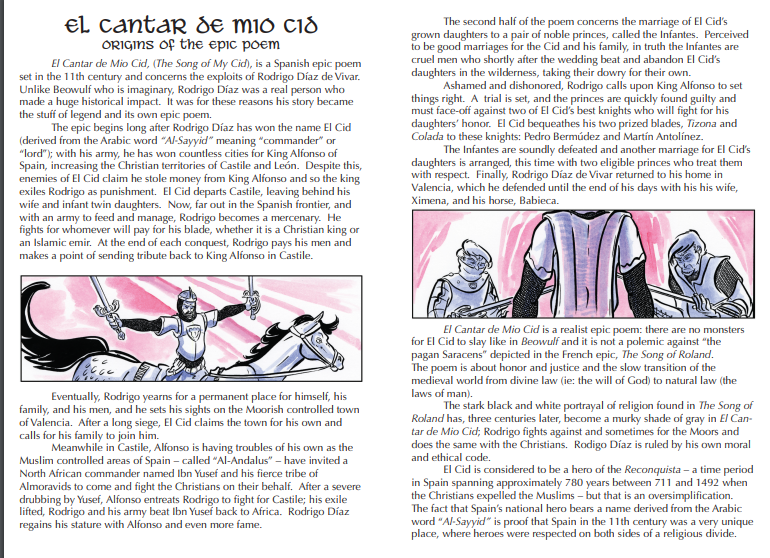******This page will host people in the comics industry who understand the value of comics in education. If you are interested in being interviewed, or have a suggestion of someone, please email me historycomicsguy@gmail.com******************
Interview with Nate Powell - https://youtu.be/n4L07GxXT_w
Intro - Joe Caramanga is a favorite author in my house as he has written great stories in Duck Tales, Frozen, and other comics that my kids and I LOVE. We are also fortunate enough to have him living in our area and have been able to meet him at signings. He also always been so kind and welcoming to all at his table and has always had a smile on his face. Joe is an “aw shucks” kind of guy an exemplifies the best of those in the comics industry. When I was conducting research on using comics with those on the Autistic spectrum, I came across his Batman story with a main character who has Autism. I knew that I had to ask some questions about the comic, and I am so glad Joe got back to me. Read the interview and you’ll see what makes Joe not only a great comics writer, but also an inspiring human being. (You can find more Autism in comics research here - http://www.historycomics.net/autism)
Tim: Hi Joe, thank you so much for taking the time to answer some questions for us. Before we get into the comic itself, can you shed some light on your connection to Ronald McDonald House, the work they do, and how donated funds are used?
Joe: My connection to the Ronald McDonald House actually started before I knew what their mission was. My first daughter suffered from complications in childbirth and for the first few days we weren’t sure she was going to make it. She ended up being fine, thankfully, but she spent her first three and a half weeks of her life in the hospital. My wife and I were very fortunate that we only lived a few miles from the hospital, but over those three weeks we met other families that weren’t so lucky. They slept in chairs, in the lobby, anywhere they could. That really stuck with me. The toughest experience of their lives, and these parents were sleeping in chairs and eating out of vending machines. Years later I found out that the Ronald McDonald House provided a home away from home for families with seriously ill children, and I knew I had to help. What’s great about RMH is that if you’re skeptical of where your donation money is going, you can donate actual household items that go directly to families. I donate 100% of the proceeds from my convention sales to the RHM of Central & Northern NJ, and sometimes to the House local to the convention when I’m traveling, and I’ve donated toothbrushes, paper towels, soap, and other items to Houses all over North America. Sometimes I’ll wrangle a couple of guys from Artist Alley and we’ll volunteer to cook breakfast convention weekend. Being able to help the charity is the greatest perk of my job. I’m not famous or anything like that but because of the nature of my job, I have a higher profile than the average person, and like my favorite super hero says, “with great power there must also come great responsibility.” (PLEASE HELP - this is the link to donate to RMH - http://support.rmhc.org/site/PageNavigator/pw/Donation_Landing.html .)
Tim - Joe, this is so powerful and I thank you for sharing your story here. My son suffers from a rare disease and has been hospitalized many times - Abington Hospital, St. Christopher’s Hospital, and CHOP. We are blessed to have so many amazing hospitals in the Philadelphia area and to live close enough to not have had to stay in a hotel and pay out of pocket. A hospitalized child is traumatic enough to a family without also having to be out of your house. My son just had a visit with a specialist in St. Christopher’s last week and there is a Ronald McDonald House right next to the hospital and we watched several families walk from the house to the hospital. THANK YOU for helping raise funds for these folks!)
Tim: In One Lock, Many Keys, the main character is portrayed as being on the spectrum – please explain why you chose to write this story. Do you have a connection to Autism?
Joe: When I had the opportunity to contribute to the anthology, I wanted the story to be meaningful. I was very interested in comics in the classroom, and how they could be used to teach and encourage kids to read, and I came across an article about how kids who are on the spectrum responded to comics. Since my cousin has a son on the spectrum and so does a good friend of mine, I felt it would be a good thing to explore further.
2. Tim: You placed some true to life ASD symptoms in the story, how did you go about deciding which to include? Did you conduct any research before writing the story?
Joe: Oh, lots. And not only from observing my cousin, but reading a lot on the subject. That includes a lot of articles about the divorce rates among parents with a child on the spectrum, which is disproportionately high. I thought that had to be part of the story as well. The ASD symptoms in the story were some of the more common ones I found, but what I really wanted to get across was the pattern of repetition. That also gave me a tool for building the tension and emotion in the story. (Tim - and it was done so well!)
3. Tim: How did you get DC to sign onto the story? Were there any obstacles to pitching the story?
Joe: I don’t remember having any problems at all, it was very well received by Mike Marts, the editor. He told me he got choked up reading it on the train, and that was such a relief since it was the first story I ever pitched to DC. (As did I - really speaks to the humans behind the comics!)
4. Tim: Over eight years later, would you change anything about One Lock, Many Keys
Joe: I haven’t read it in a long time, so I wouldn’t know. Nor would I want to! I’m fine with the romantic version of it that’s built up over time, haha.
5. Tim: As an educator, I’m curious if you gave any thought to how this could be used in a classroom – either for students with ASD, for students to learn about ASD peers, or for education students? If you were speaking to educators about the use of comics to help with understanding ASD, what would you say? (with this story or other comics)
Joe: It was the basis of the story, it’s something I think about a lot—not just for educating people about ASD, but for educating them about everything. Story has been an educational tool since the beginning of time when people were drawing on cave walls, so we know it works. For a long time there was resistance to using comics to educate, but we’re finally starting to come around on that. (Absolutely - it’s been a long journey for us spreading the comics in education message, but we’ve made great progress. Stories like yours make it all the easier to convince those who question comics as meaningful literature).
6. Tim: Have you worked on any similar comics? What stories would you want to see told in comics that could help with autism or other difficulties?
Joe: I try to have something meaningful to say in all of my stories, whether subtly or not-so-subtly, but this is the first time I wrote about autism. I’m not sure I’m qualified to know which stories could help, but comics themselves could help teach us a lot because comics have a quicker pace to them than prose which keeps your eyes and mind active and the art certainly holds your attention. I’m glad more educators are using them.
7. Tim – before we let you go, please let us know what you are currently working on, what’s coming out in the near future, appearances, etc.
Joe: I’m currently the writer of Disney’s Frozen for Dark Horse Comics, and Disney’s Big Hero 6 for IDW. I’ll be writing Disney’s DuckTales for IDW again at some point, and I have other Disney projects in the works!
8. Tim: Thanks again, Joe. Please let us know where to find you on social media and the internet -
I’m on Twitter @JoeCaramagna. Come say hello! (Joe has a link pinned on his twitter account where you can buy items from Amazon that will ship directly to RMH - let him know you are helping!)
_______________________________________________________________________________________________________________
_______________________________________________________________________________________________________________
I just read Spider-Man Noir, the Complete Collection (2019) written by David Hine, Fabrice Sapolsky, and Roger Stern, with stunning art by Carminie Di Giandomenico, Richard Isanove, Bob McLeod, and Paco Diaz. (ISBN 9781302919580). I first found interest in the character after watching the unequaled movie Spider-Man: Into the Spider-Verse. To be honest, it was my 11 year-old son who begged me to buy the book as he wanted to learn more about the character in the story. (This is a perfect way to engage students in reading – buy the book that goes with the movie, TV show, or video game). As a history teacher who has found a lot of success integrating comics as educational resources, I was immediately drawn into the history woven throughout the comic. The Great Depression is the backdrop to the compelling story line and I found myself reading it with sticky notes and lesson plans forming in my head. It is stories like this that will immediately pull our students into history by engaging their imagination and thoughts of “what if” surrounded by well-researched historical events. I was so excited when David Hine responded to my message and agreed to be interviewed here. I will first post the interview, and then my lesson plan ideas will follow.
1. Dave, thank you so much for agreeing to answer some questions about Spider-Man Noir – the implications for its inclusion into the classroom is astounding. First, some info about you – could you give us some background on the work you have done in comics?
DAVE: I’ve been working professionally in comics since the early 1980s, beginning with British comics. Some of my earliest work was as an artist for Marvel’s UK office, which published new material distinct from Marvel’s American comics. I moved on to write and draw for the science-fiction weekly 2000AD, and finally wrote and drew my own series called Strange Embrace, which was later published in the USA as a graphic novel. That led to Marvel offering me work as a writer on some of their key characters including X-Men and Daredevil and from there I went on to write for DC comics, Spawn and a number of creator-owned independent comics in the USA and the UK.
2. Why comics? What brought you to want to be involved in the comics industry?
DAVE: From a very early age I knew I wanted to be a writer. I wrote my first (very short) science-fiction novel when I was eight. I had always read British comics but it was when I saw the imported Marvel comics like Spider-Man, Thor and Fantastic Four, that I realized I wanted to put words and images together to tell my stories. I was probably thirteen when I settled on creating comics as my goal in life. There’s something about the combination of words and pictures that is unique and satisfying to a storyteller. It’s also a lot cheaper than making movies! The whole community of comics has always been very welcoming and supportive too, both among the fans and professionals.
3. What are your thoughts on using comics in the classroom?
DAVE: Comics are a great entry point to reading. Working with young people I can see how using comics breaks through a lot of resistance that they sometimes have to reading a lot of text on a page. We all first learned to read with simple picture books and comics are a major step up from there. They are both a gateway to reading novels and textbooks, and also a valid art form of their own. We are living in such a visual world that young people automatically handle that simultaneous input of words and images. It’s natural to combine the two as a kind of hybrid language that communicates directly and dynamically.
4. In your message to me, you said that you are currently a mentor to school and university students in making comics at Pop Up Projects (pop-up.org.uk). You said, “It’s all about getting young people to see that they can make art and literature on their own.” This sentence really resonated with me and I couldn’t agree more!
I also looked up Pop Up Projects and found this quote on their About Us page –
“About Us – “Pop Up Projects are a not-for-profit Community Interest Company, established in 2011. Since 2015 we have been an Arts Council England National Portfolio Organisation – NPOs represent “some of the best arts practice in the world, and play a vital role in helping meet the Arts Council’s mission. We firmly believe that access for all children and families to the broadest range of published, live and digital literature is a universal right. In all our work we facilitate access to rich and meaningful literary experiences for children and young people, schools (primary, secondary, SEN) and families – especially in diverse, deprived, isolated and otherwise challenged communities.” Wow!!!!! Can you please expand a bit on the organization and what you are doing?
DAVE: This is my first project with PopUp and in my case I am one of three comics creators, going into a school in Eastwood, where DH Lawrence was born, to encourage students from the Secondary school and from the University of Nottingham, to create their own comics based on Lawrence’s writing. The idea is to explore his work in relation to their personal experience and to the history of the area. For most of them it’s a first taste of making comics and it’s great to see them getting excited by the stories unfolding on the page as they work. This project is also linked with UNESCO, as Nottingham is a UNESCO City of Culture, and we have funding for the finished comics to be printed by a leading British graphic novel publisher, SelfMadeHero.
PopUp are very much focused on schools in deprived areas. These kinds of activities tend to be more available to wealthier families, particularly in London and other more affluent areas. We want to show these young people that everyone can make art, both as a hobby and as a career. I grew up in a working class home where the assumption was always that the creative jobs were not available to us. Even my own parents couldn’t accept that art was a viable career and I had to fight to go to Art College instead of getting a ‘proper job’. In a world of shrinking job opportunities the arts are going to be ever more important as a part of people’s lives. It’s vital that everyone has equal access to making and enjoying the arts, irrespective of background or income.
5. Why did you decide to write this particular story-line centering on Spider-Man and the Great Depression? What was the inspiration?
DAVE: My co-creator, Fabrice Sapolsky, first came up with the idea of doing a ‘pulp’ version of the character, set in the 1930s and we pitched the series to Marvel Comics as an alternative version of Spider-Man with a Film Noir feel to it. It made sense to set it in the Prohibition era, which is also the period when the traditional movie-style gangsters flourished. I started reading up on American history for the period. I’m English so my knowledge of the 20th Century history of the USA is sketchy to say the least. What I read of the politics and social background of the period was fascinating. I read up on the Great Depression and the horror of the shantytowns, known as Hoovervilles after President Hoover, where the unemployed lived in appalling conditions. It also made sense to reinvent Peter Parker’s family as socialists. Even in the early version of Spider-Man that I read in the 1960s, Peter Parker and Aunt May were portrayed as underdogs, always struggling against poverty. Once we decided on the setting all the other details fell into place as I read up on the social history of the Depression and its impact on working class people, who often ended up without jobs and no safety net to protect them.
6. As a social studies teacher, I was impressed with the amount of historical connections during the Great Depression, in addition to the compelling fictional story-line. Please describe for us the process you undertook to research for the book. Did you interview anyone, visit the library, rely on a specific source or two? What were some of the most difficult parts of the process?
DAVE: I have a terrible habit of underlining passages and making notes in margins, so I tend to buy books in preference to using the library. I bought William E. Leuchtenburg’s Franklin D. Roosevelt & The New Deal, Robert S. McElvaine’s The Great Depression, and Public Enemies by Bryan Burroughs for background on gangsters and the early days of the FBI. General history books were good for checking events against dates and then the good old internet filled in the gaps. We tried to be very careful not to make any factual errors. We initially thought about having the black journalist Robbie Robertson working for The Daily Bugle but my research made that look highly unlikely. There simply weren’t any African American journalists working on the mainstream newspapers. So we had him working for The Negro World, a leading African American newspaper that ran from the late 19th Century until 1940.
I also turned up a lot of very disturbing facts about The Friends of New Germany, the American version of the Nazi Party. And of course the idea we explored in the second series, Spider-Man Noir: Eyes Without a Face, of medical experiments on African Americans, though fictional, has resonance with the Tuskegee Study of Untreated Syphilis in The African American, where treatment was deliberately withheld from hundreds of black men with syphilis over a period of forty years. We really didn’t need to exaggerate much.
I dropped in as many references as possible to real world elements. The villainous Dr Otto Octavius quotes Rudolf Kjellén, the Swedish political scientist who came up with a lot of the ideas about Geopolitics that Hitler later espoused. On the other hand there are a few fictional elements. We have Spider-Man Noir raiding a club called Seventh Heaven in Harlem. It never existed, but we do drop a mention of the Cotton Club, The Savoy and the Radium – all real Harlem locales.
Basically you can take most of the references and use them as springboards for research into the period, though we tried not to make it too heavy-handed. The language is pretty authentic too. I collect dictionaries of slang so they came in very useful.
7. What was it like working with the artists and getting the illustrations to match the historical events? How involved were you in the process?
DAVE: I did a lot of picture research as well. I usually supply photo reference to artists I work with, particularly if it’s a specific period or location. With a big publisher like Marvel you don’t really communicate directly with the artist. Everything goes through the editor and assistant editors and there can be occasional failures of communication. In an early scene in the first series, May Parker is giving a political speech in a location that is specifically the Riverside squatters’ shantytown in NYC. The buildings in the drawings were a little too solid and sophisticated compared to the ramshackle reality. In the original artwork they even had electric lights, which I asked to have removed. I’m a bit pedantic at times.
There was one error that stood out for me like a sore thumb. In Eyes Without a Face, there’s a scene where Felicia seduces Peter Parker and she was drawn naked under her robe. Only a back view but I was told that it had to be censored because the drawing made it clear that Peter could see everything even if the reader couldn’t. This was a decision made late in the day and underwear was added. Unfortunately the skimpy underwear was more Victoria’s Secret than 1930s lingerie. I didn’t see that until the comic was printed so it was too late for me to gripe about it.
Otherwise I think we were all good. Carmine Di Giandomenico is a great artist and has a lot of experience drawing period comics. His vehicles, costumes, buildings and interiors were all spot on.
8. What is your favorite part of the book?
DAVE: I really enjoyed the Aunt May character. She is totally fearless and her principles are unshakable. When one of the Goblin’s gangster enforcers tries to stop her making her socialist speeches, she faces him down with the line “Young man, the last time I looked, the constitution of this country protected my right to freedom of speech.” Later, Spider-Man Noir saves her life by shooting the Vulture. Instead of thanking him, she yells at him for using a gun.
9. What, if anything, would you have done differently if given the chance? Add any characters? Were there parts that were left out?
DAVE: That gun would probably go. Marvel wanted him to have a gun. I guess it was justifiable for the period and context but we should probably have used Fabrice’s idea of non-lethal ammunition – smoke pellets, mild electric shocks, maybe something like that.
The way we ended up handling it, he carries his Uncle Ben’s service revolver and, after Aunt May tells him off for killing the Vulture, we rarely see Spider-Man with a gun again, except when he takes weapons off the gangsters at the Harlem night club and fires them into the air. They still feature a lot on cover images though, and one of the action figures that have gone on sale, has him with a gun in each hand.
We went through a few changes as plots were discussed but I’m pretty happy with how the stories turned out. I think Fabrice wanted to include a lot more of the cast of characters from the Spider-Man universe and give them that 30s twist. We also had ideas for carrying the character forward and maybe age him realistically so that we see him reacting to the social changes that came about in the 1940s and 50s.
10. Do you have any advice for teachers in using this book?
Dave: The kinds of things you have talked about seem perfect for history lessons. Get the students to look through the comics for references to specific events, characters and political issues. Then encourage them to research those things, to expand on them and see how the issues relate to the present day. Depending on how controversial you want your discussions to get (and I do have a tendency to raise controversial issues), I could see explorations of extreme politics, gun control and racism at the very least.
Regarding Franklin Roosevelt and the Democrats in the early 1930s, I found it interesting to read that, at the time, the Republicans were seen as the party of racial equality, while Roosevelt was held back from working towards full integration by Southern Democrats. The role of Eleanor Roosevelt was very important in speaking for civil rights for African Americans, something I refer to briefly, but my knowledge is very patchy. I feel like I need to take a few lessons in 20th Century American history myself.
11. What new projects are you working on?
Dave: Sonata is the first of a series of projects I’m working on with artist and co-writer, Brian Haberlin. The second will be announced very soon. Those are both being published through Image comics. In the UK I have recently published a graphic novel called Lip Hook with art by Mark Stafford. We have another one called The Bad, Bad Place out later this year. Then there’s work for the Judge Dredd Megazine, the companion title to 2000AD here in the UK. I have just finished a series featuring Judge Death, with artist Nick Percival and waiting on the green light for another series.
Dave, thank you so much for your time and amazing stories! Below are some initial thoughts I had while reading Spider-Man Noir and how it can be used in the classroom:
DAVE: I read through the list below and I’m very impressed. You picked up on so much! I’m glad my research is pretty solid. I would feel like an idiot if I had made errors. By the way, the use of troops against demonstrators in 1932 was doubly ironic as they were used to clear the campsites of the ‘Bonus Army’ of 20,000 WW1 unemployed veterans who were gathered in Washington to demand the compensation promised to them for lost earnings during that war.
*What is the actual power of the press? Can photographs of events change governmental policy or get people to care? What pictures were taken by journalists during the Great Depression? If I was a journalist, what would I want to take pictures of? What would have the greatest impact on helping those suffering during the Great Depression? Then I would have my students research journalists throughout history – what have been the pictures with the most impact? Who are the journalists behind the photos?
*”Three years ago, Hoover was telling you your jobs were secure for life. Since then, more than thirteen million of you are out of work! We’ve seen the army on the streets, using tanks and tear gas against citizens whose only crime is their poverty!” – May Parker. Such a loaded bit of dialogue that can lead to much research. Who was Hoover? What was his role in the Depression? Did the government send in troops/police against those who were impoverished? Why? How?
*”Now we’ve got mister Franklin D. Roosevelt waiting to step into Hoover’s shoes, but you think there’s going to be any real change? Republicans. Democrats. The only thing they’re debating is the most efficient way to turn your sweat and blood into profit.” – May Parker. This would the perfect chance to ask students about their prior knowledge of FDR and the New Deal. Did it work?
*”So you want to join the Fourth Estate?” – J. Jonah Jameson. What is the 4th estate? What role does it play in history?
“We’ve got a new President and a New Deal. And the same bums are still lining up for Aunt May’s soup.” – people lined up at the “Bowery Welfare Center” – there is a Bowery Mission in NY since the 1870s – are they the same? Evaluate the New Deal. When did it begin to make an impact? How long did the Great Depression last? (students are often surprised that is wasn’t just a year or two).
“Not the colored workers! The Democrats have never done a damn thing for us and Roosevelt is no different! I’ll tell you what his precious N.R.A. stands for… and it isn’t National Recovery Act. It’s Negroes Robbed Again!” – research the N.R.A. – did it work? Why did “Negroes” feel left out? How did the New Deal impact minorities?
“…even with lynchings back up to two a month, Roosevelt has refused to back an anti-lynching bill because he won’t risk losing the support of the Senate on more important issues.” – what was happening to African-Americans during this time period? How did FDR react? Did he do anything?
“So how is it at Negro World?” – what Black papers were in circulation at the time? What was published?
*At Ellis Island – “It’s hard to believe that millions of immigrants were processed through here. My Great-Grandparents must have stepped off the boat right on this spot.” “Not mine. I’ll venture that my ancestors were a little less optimistic about their prospects than yours when they set foot on American soil.” – Why would an African-American say this at Ellis Island?
*”The flow goes the other way these days. That’s the deportation holding center over there. Last stop for all the undesirables who don’t fit the picture of the perfect American citizen. Criminals, subversives, communists, anarchists…” – was Ellis Island used to also deport people? Why would these types of people be deported? What is the history of Ellis Island?
*Doctor Octopus, and others, are experimenting on African-Americans on the island. So many connections to the Tuskegee Experiments, Nazi experiments, eugenics, and even philosophical debates on medical research. Certainly not an easy topic, but one of such vital importance to our shared history and ties to current events.
*Role of Nazis in the United States before WWII. Discuss Nazi rallies, Madison Square Garden, etc.
*Rudolf Kjellen and biopolitics. Who should be eliminated to endure the survival of the state? Bioethics…
*Connections to apartheid and South Africa
*So much going on in the art – such as fashion. Zoot Suits – research Zoot Suit Riots and the pop song.
*Role of J. Edgar Hoover
*Prohibition, Al Capone, John Dilinger…
These are just some of the ideas currently swimming through my head as I revamp my Great Depression unit for next year. I don’t want to give too much away, but having the Goblin next to Capone, Doc Octopus with Himmler… wow!
Dave also emailed to let me know about his thoughts on research in writing Daredevil - “I had a similar response to an old Daredevil story I did (Daredevil:Redemption) which was a story based on DD's life as lawyer Matt Murdock. I spent 5 weeks researching the legal details for one episode and I had my doubts over whether I was wasting my time. Then recently I heard from a lawyer who wrote an article for the Law Review on Daredevil comics that were accurate representations of the legal system. He picked up on all the details I had researched. It really does make it worthwhile.” I just ordered a copy from my local comics shop! Can’t wait to read!
Thank you for reading this interview and be sure to check out the work of David Hine - especially his new stunning new series Sonata, published by Image Comics. Hine has once again written a comic with many uses in the classroom - geopolitics, scarcity, ethnic conflict, imperialism, race for technology, strong female lead… it’s like taking a long hard look in the mirror of our humanity…
______________________________________________________________________________________________________________
For our third interview - My 7th grade daughter has an absolute favorite graphic novel and the author/artist was kind enough to answer her interview questions. In a house full of comics, that this is her all-time favorite is a powerful compliment. I had the pleasure of meeting Matthew Loux at NYCC and he was not only gracious enough to sign a copy of the book for my daughter, he even drew her favorite character for her. As a history teacher, this was also a stand out book for me as well. Below is my daughter’s review of the book, followed by her interview.
“ I have been waiting eagerly for the sequel to the amazing graphic novel, Time Museum, written and illustrated by Matthew Loux and published by 01 First Second. Basically, it’s mainly about the dangers and excitement of time-traveling and the wonders of learning. The main character, Delia Bean, is an intelligent young girl with an unwavering love for learning. Not surprisingly, she is valedictorian of her school and proposes new theories about daily organisms most care not to notice. Although her differences from the rest of her classmates make her feel isolated at times, she has one occasion to look forward to- going to Uncle Lyndon’s house. There Delia can relax and be her nerdy self, since her uncle is an intellectual like her. Everything is as usual at his house, mainly days of observing and researching, until a small kiwi bird catches Delia’s attention. Obviously with her vast range of knowledge, Delia runs after it wondering how in the world it had traveled from New Zealand to North America. The truth was more mind-blowing than Delia could ever comprehend. When the kiwi finally came to a halt, an immense museum full of valuable artifacts and real figures from throughout history lay in shining glory, right in front of Delia. Apparently, Uncle Lyndon was a time-traveler, conserving treasured artifacts of history. Once in on the secret, her uncle informed her that she was invited to compete against kids her age from different time periods for an internship at the museum, much to Delia’s delight. In addition to this storyline, humor was an active part in this graphic novel, and the facial expressions on character’s faces made me laugh, even in the most serious of situations. One of my favorite scenes was on page 146, when all the contestants came together to explore the Garment Center: It portrayed unlimited clothing from every era- for free! There, Delia Bean changed into a classic Jane Austen outfit, giddily flouncing out and quoting the famous line, “It is a truth universally acknowledged that a single man in possession of a good fortune, must be in want of a wife,” a clever allusion to Pride and Prejudice! Immediately she stops short as she notices the boys snickering and all the girls dressed in the same outfit. I cracked up when Reginald, another contestant, whispered, “All girls are suckers for Jane Austen,” while the boys just stared on with weird fascination. But most of all, I felt strong connections to the main character, Delia Bean. Being a red-headed girl with a tremendous curiosity and aptitude for learning, I saw a reflection of myself. I could absolutely put myself in Delia’s shoes, without any hesitation and really anyone with a natural curiosity of the world will probably feel the same.” - Charlotte, age 12.
Interview:
*Why did you choose graphic novels? What drew you into graphic novels? - Charlotte
-When I was in art school I had many friends who were into all sorts of comics, including what we would call the Direct Market, Super hero style, stories. I grew up liking some of those characters but honestly never really enjoyed the floppy comic format of short bits of story that were both filled with ads and were also getting more and more expensive. Buying a full story in graphic novel form, something you could put on your bookshelf, just made way more sense to me. I also liked the idea of purposefully telling a longer story in one go without having to worry about structuring the narrative so it would also work as a single issue.
Around this same time I started to discover indie graphic novels from the 90’s which were often one creator doing everything and telling any kind of story, not just a super hero tale, which at the time was kinda’ rare. This is when I first read different genre’s of comics like fantasy or slice of life and It really appealed to me. What was even more important to me was how different the art styles in these books often were. I learned early that the way I most comfortably drew characters would never be in line with the big two (marvel and DC) so it was inspiring to see comics being published that looked so different. It made me start to think I could do that too. – Matthew Loux
*What are the challenges of creating a comic book all by yourself? - Charlotte
The biggest challenge is the time it takes to do everything. On my books I’m the writer, designer, thumbnail artist, penciler, inker, colorist and digital formatter, and there’s probably some other things I do that I’m not thinking of right now. The advantage of doing all of this is I can have crazy control on how I want everything to be, which honestly is something I really like, but it takes lots of time. The last book I finished was Time Museum Vol. 2 and it took me over 2 years to complete, which isn’t really that bad, but I would like to be faster because there are lots of comics I want to do. There are, of course, plenty of other challenges like organization, remembering to format my pages correctly, remembering not to drink too much coffee if I need to ink all day. One of the biggest challenges though, is to keep working even when I really don’t want to. I try to find ways to remember what inspired me about the story or art, and I even look at other artists I admire for motivation. And one of the most important things about working on a long project is to get out of the house and meet with other cartoonists when I can. They’re the only ones who really know what I’m doing and what I might be struggling with, so it’s great to be able to talk craft with your peers. – Matthew Loux
*What was your inspiration for creating this particular story?
For The Time Museum I wanted to do a different genre than my last series. Salt Water Taffy was set in modern day but was a throw back to old New Englandy folklore. This is something I adore but isn’t always the most appealing to everyone. I wanted to do something that would feel a little less niche and that might be more accessible, even a bit exciting. I also love Sci-fi and enjoy time travel stories (though I’m far from an expert beyond Back To The Future). The tough thing is figuring out what I could do that would make a time travel story different than the many others out there. This is a story prompt I do to myself with different genre’s sometimes to see if I can come up with interesting ideas. At the time I was living in Brooklyn, NY and I love going to the Metropolitan Museum of Art in Manhattan along with the many other NYC museums. When you’re exploring the Met in particular, it can feel like time traveling as you walk from one wing, housing Egyptian statues, then suddenly step into a section on medieval European armor. This sort of naturally brought me to the idea of “what if they got all this stuff by time traveling?” After that everything else sort of fell into place. I liked the idea of a kid finding this museum, almost like in Alice in Wonderland, and trying out for a job there, cause let’s be honest, that would be a really awesome job.
*As a curious redheaded girl myself, why did you choose Delia Bean as your main character?
My last series starred two boys, so I wanted to finally write a girl main character, so that was the starting point. Interestingly when I first began sketching loose ideas and characters, I originally had Delia as an Asian girl. There was a big gap of time between first coming up with the idea for the Time Museum and when I really got into working on the original pitch, so I didn’t really change her to Caucasian on purpose, I just forgot that original thought and she had already begun to evolve differently as a character. Ideas sometimes work like that if you can believe it. Since the story revolved around a museum, I liked the idea that Delia would be pretty studious and very curious, and also that she would love things that most kids didn’t, like bugs, because she finds them scientifically fascinating. I also liked that her love of learning was also a way of avoiding her own social awkwardness. Delia pretty quickly became fully formed in my mind. As for being a redhead, I honestly think I was gonna give her light brown hair but the first time I did a full color character design of her I immediately made her hair red. It just looked better for Delia.
*What’s your favorite era of history?
Good question. As an artist I tend to base my answers to this on places and times I find visually interesting, so I’ve always loved ancient civilizations like Egypt, Greece, and places like Angkor Wat. I also love Japan and travel there often and I would love to visit several of their era’s. One I like in particular is Japans early Meiji Era, around the 1860’s, where after being almost completely closed off from any other foreign countries for over three hundred years they are forced to open their boarders by an American warship. In doing so, Japan discovered how technologically behind they are from the rest of the world which starts a supercharged race to catch up with the West and it created a very interesting mix of ancient traditions with modern western styles.
*As you used a main character, Michiko Oda, who is set in the future, what do you think is in store for us later on?
That’s a tough one to predict. It’s a fact that there will be tremendous challenges to everyone on this earth due to climate change but hopefully this will eventually unify the world, not divide it. I think technology will have the chance to help improve lives. I don’t know if humanity will get any smarter though.
*Please, Please, Please, tell us a little something about book 2 because I can’t wait to read it?
So the Bean Team has had some setbacks in there last few missions and have to figure out some ways of fixing their approach to being an Epoch squad. Delia becomes involved in a bit of a love triangle, also there are two Delias and half the book is spent trying to stop a major paradox from happening.
*Are any of your characters based on people you know or have known? Does Sir Walter, Uncle Lyndon, or Ms. Alice Pinkerton have a connection to your life?
Not really. I created those characters and their personalities mostly to complement the kids, story wise. Uncle Lyndon might be a little like my dad though, mostly cause he is extremely supportive to talk to and has similar interests to me as Lyndon does with Delia. I did have a starting point with the look and eventual design of some of those characters. My starting point for Lyndon was David Lynch, so when I read or write his dialogue he always has a more high pitch sort of voice. When designing Ms. Pinkerton I sort of wanted her to look a bit like Freema Agyeman. And with the Grey Earl, it might be obvious that David Bowie was an influence.
*What are your thoughts on using this comic in the classroom?
I think it’s great! An honor really if a teacher thinks it would be a useful teaching tool. I don’t write it to teach though. I depict time periods and I try my best to do so correctly, but I also don’t want research and detail to bog down my stories. If it gets kids interested in time periods, stories or in telling their own story, than that’s a wonderful thing.
Or I guess you could use it for math class too, like one Time Museum book plus Time Museum Vol. 2 equals how many different outfits… or how many times have I drawn Delia? I don’t think I actually want to know that…
*What outfit would you wear from any era of history from the “ Garment Center?”
There’s a very cool, mod style, suit with a red blazer That Delia wears in Time Museum Volume 2 on her way to a punk rock club in 1970’s London. I would love to have that suit. Also anything the Beatles wore.
*Thank you for your time and all of your hard work. Do you have any parting words of wisdom for us?
Thank you for these awesome questions and I am soooo excited for everyone to read Time Museum Volume 2 when it’s out June 11th! It’s a book I am very proud of and if you liked the first Time Museum, I really think this one will knock your socks off! I love continuing to create this world and these characters and I truly hope kids connect with them as I have!
_________________________________________________________________________________________________________
For my second interview, Alexis E. Fajardo discusses his fascinating graphic novels of Kid Beowulf that have created an entire category all onto their own. I was lucky enough to have read an advanced reader's copy of his newest book, Kid Beowulf: The Rise of El Cid, which will be available on August 7, 2018. His books create an amazing world of history, literature, and mythology that will engage students on many levels. Lex's historical research process is amazing and inspiring! These books are perfect for the classroom and will spark much imagination, discussion, learning, and fun in the classroom. Read my review of this book here - http://www.historycomics.net/featured/
QUESTIONS FROM TIM SMYTH –
1. Your bio - include whatever contact info you’d like to share - website, twitter, etc.
My name is Alexis (Lex) Fajardo and I’m the cartoonist and creator of the graphic novel series, Kid Beowulf. I’ve been writing and drawing the series for years and it’s now published by Andrews McMeel Publishing. I live in Santa Rosa, California where when I’m not working on Kid Beowulf, I work as Senior Editor at the Charles M. Schulz Studio. You can find me on twitter and instagram under the handle @lexkidb and find more of my work at www.kidbeowulf.com (The website is an amazing resource - contains book trailers, interviews, previews, and games! - Tim)
2. What’s your comics background? What projects have you done? Why comics?
I’ve been a professional cartoonist going on twenty years or so. Originally, I started out doing a comic strip online (Plato’s Republic 2000-2008) and I submitted it to syndicates in the hopes of getting syndicated (I have LOTS of rejection letters). When I started doing Kid Beowulf, it was a fun little distraction, but the more I worked with the story the bigger it got and so I shifted gears to more long-form storytelling. It’s had a long history in self-publishing and traditional publishing and I’m happy with its new home at Andrews McMeel. I started working at the Schulz Studio in 2007 and have been lucky enough to work on a number of projects, including the monthly PEANUTS comic book series published through BOOM Studios. That’s been a terrific series to edit and be a part of and has informed my own creative process. As to why I chose comics, I think like a lot of cartoonists, comics chose me; it was the one art form I’ve always gravitated too since I was a kid. I love learning about its history, how it works as storytelling, I love the variety of cartooning styles and languages. It’s an endlessly fascinating art form and I’m proud to be a small part of it.
3. What do you see as the value of comics in education?
I think education is about disseminating complex ideas to students that will (hopefully) spark further exploration by those students of those subjects; it’s not about giving the answers, it’s about igniting curiosity. We’ve always been a visual culture but I think in recent years that’s only increased and the visual language of comics is the perfect medium to help break down complex ideas and help represent them clearly; whether it’s math, coding, science, or literature. Comics are a great tool for any teacher to have in their arsenal. They can tackle hard ideas on their own or be used as a bridge to more complex learning.
4. Explain the process of creating a comic adapted from widely known stories in our culture. What are the inherent difficulties/benefits of this type of storytelling?
For me, first and foremost, I want to tell a good story and create interesting three-dimensional characters who live on the page. I’ve always loved these old epic stories and long before they became the subjects for professors and PhDs they were stories told around a campfire and that’s how I like to approach my retellings.
When I begin, it all starts with the source material (in this case the Spanish epic poem El Cid). I read several different translations several times over and try to pinpoint the themes. I also read essays and critical texts on the poem to understand how it’s been interpreted. Then I read a variety of history books to try and understand the culture of the time. All the research goes into a big melting pot of ideas and that’s when I start to craft the story. Sometimes ideas I really loved at the start don’t make it into the final version, other times characters start dictating the path of the story.
With historical epics, I sometimes get trapped by geography. For instance, in the original notes of El Cid, I wanted the final confrontation to take place in southern Spain at an early “Red Fort” version of the Al-hambra, I thought that would be a symbolic convergence of people, themes, and religions. I soon realized that I could not get all the key players there convincingly to make that setting work so instead I moved the finale to central Spain, in Toledo, which ultimately worked just as well, still made all those themes resonate, and was more natural to the storytelling.
4. What’s your favorite panel/page and why?
That’s a tough one. Artistically, I feel like my style started to come together with book three, so there are several bits I like. My favorite might be the opening of part two, it’s a flashback to Rodrigo Díaz’s (El Cid) youth and I tell the story of how he got his famous horse, Babieca. That was a fun sequence to do and I think the drawings of the horses turned out okay (horses are really hard to draw).
5. What specific projects have you worked on that would be great for classrooms?
I think the Kid Beowulf series would make a good fit for classrooms. If teachers have students who enjoy George O’Connor’s Olympians series or Jeff Smith’s Bone books, I think they would like Kid Beowulf. (My own kids love these books and Kid Beowulf, so I can personally attest to this fact – Tim) What I really like about the color editions from Andrews McMeel is the backmatter we put in each book, they’ve got character glossaries, maps, key terms, fun facts, and a bibliography. Ideally kids could read the story for fun on the first pass and for those students who like to dig a little deeper we’ve given them those tools to do so.
6. What advice do you have for educators on how to use your comics?
Gosh, that’s a great question. I think ultimately, I would encourage teachers and students to read the stories and just talk about them, maybe identify what themes resonate with them, which characters pop out to them, what drawings they liked and why. I know I pack a lot into these stories (with varying degrees of success), but I try to put enough in them that something about the tale will resonate with any reader, whether it is a specific character, idea, or drawing. I never want to be overly didactic with the books I write, but I do want them to be dynamic and fun.
7. What new projects do you have coming up?
I’m currently penciling book four in the series “Kid Beowulf: The Tarpeian Rock.” In that one, Beowulf and Grendel meet another pair of ill-fated twins, Romulus and Remus and it touches on the founding of Rome. I like how this one is coming along. I also have done a number of Kid Beowulf side stories that expand the universe a little bit and I hope to collect those in one volume soon. There are so many great myths, legends, and epics to explore – it’s a thrill to share them with new readers. (As the Roman Empire is fascinating to me, I personally cannot wait for The Tarpeian Rock! – Tim)
Thank you so much, Lex! I have a great admiration for the level of research you have put into your books and the funny and engaging way you have illustrated them. The publisher of Kid Beowulf has also created teacher lesson plans to go with the books - check out http://kidbeowulf.com/kid-beowulf-teachers-guide/ - these were written by Tracy Edmunds - an amazing educator and friend. I have also written a review of the book here - http://www.historycomics.net/featured/ . See some images from his newest book below - I personally chose them as they speak to the value of this book in our classrooms.
I am so excited to share the very first of the creator interviews as it is with a person who inspires my kids and myself. Dwight MacPherson has published his own comics through HPComics and saw a need for his medium through his own son, much like I began my journey as inspired by my own son, Liam. This interview blog will be populated by creators whose work I find perfect for the classroom and that I personally enjoy. I will not be reaching out to folks just because - the amazing people you find here will be those who I personally find inspiring and who are just good people. I was honored to have Dwight and his amazing wife, Rebecca, reach out to me and ask that I do some educational outreach work for them and their comics. It is truly a blessing when you are asked to "work" for people whose work you already admire. Dwight sees so much value in creating comics for the classroom and there are so many great adventures on the horizon! If you have any follow up questions, feel free to email me (historycomicsguy@gmail.com) or follow Dwight and HP Comics and ask them yourself - @D_MacPherson and @HPComics_ . We are working collaboratively to create teacher lesson plans and guides for all of his comics - James Caudill is also an amazing comics educator who is working with us as well - follow him on Twitter @TeachCaudill. Seriously - Dwight and Rebecca are good people - they make me laugh and make me think - they have a deep love for each other that shows through in their dedication to comics and education. They also serve as an inspiration to those looking to break into the comics industry as they just keep on keeping on and creating comics that they find value in. This is not about chasing the almighty dollar or for humongous fame - they create because they believe. I can think of no better story to share with my children and students than what they have accomplished and are planning for the future.
Q. Can you tell us a little about yourself and your background?
A. DLM - I'm a Michigander by birth, but my family moved to Florida when I was 9 years old so I grew up there. I proudly served as an Army Medic for 14 years until I was medically separated. During my time in the Army, I did tours in Saudi Arabia and South Korea. I wrote my first comic, 'Dead Men Tell No Tales', at Camp Casey, Korea, and it is this graphic novel that lead to me meeting my amazing wife, Rebecca. She purchased 'Dead Men' when she was living in Hollywood and working as an independent producer of theatre and film. She contacted the publisher, who in turn passed on her information to me and two years later, we became husband and wife. We have 3 sons: Clayton, Duncan, and Logan, who are our biggest inspiration to write the best stories that any reader--of any age--can enjoy. My work has been published by DC Comics, Image Comics, IDW Publishing, and many others. We started Hocus Pocus Comics a little over a year ago and we already have three comic series on ComiXology and Amazon Kindle and four successful Kickstarter campaigns under our belts. You can find us at our website, hpcomics.net, on Twitter (@hpcomics_), Facebook (www.facebook.com/hocuspocuscomics), YouTube (www.youtube.com/channel/UCJxIKAGhiJrnzYgqBYlX1pw), and on Instagram (www.instagram.com/hp.comics/).
Q. What’s your comics background? What projects have you done? Why comics?
A. DLM - Wow. There are so many. [laughs] The projects that I'm best known for are 'Sidewise,' 'The Surreal Adventures of Edgar Allan Poo,' 'Kid Houdini and the Silver Dollar Misfits,' and 'Dead Men Tell No Tales.' My very first comic, 'Dead Men Tell No Tales' #1, was published by Arcana Comics in February of 2005. 'Sidewise' is an original digital project that I created for DC Comics' Zuda imprint. It's still available in DC's shop and various digital comics sites. 'The Surreal Adventures of Edgar Allan Poo' was published by Image Comics in August of 2007. I received a Harvey and Eagle Award nomination at the time, but ultimately lost to Perry Bible Fellowship's Nicholas Gurewitch and Alan Moore. Yes, THAT Alan Moore. 'Kid Houdini and the Silver Dollar Misfits' was published by Viper Press in June of 2008. I'm also the co-creator and co-writer of the Howard Lovecraft trilogy with my good friend, Bruce Brown. Two of the books have been adapted into films, but I had nothing to do with them, so don't blame me. [laughs] In addition to these, I've written a lot of short comic stories and edited many comic series. You can find an exhaustive list of my work at http://www.comicbookdb.com/creator.php?ID=2737 and my Amazon Author's Page: www.amazon.com/Dwight-L.-MacPherson/e/B00355KG1K.
Why comics? Well, they're in my DNA. Some of my earliest memories are of me reading, drawing on (yes, I got many spankings for it), and making my own comics. I love the medium. I've always said that comics are the marriage of literature and art. They engage the senses and stay with you forever. The good ones, that is. Well, to be honest, I can still remember many of the bad ones. Kinda like the way that I can't forget Toni Basil's 'Oh, Mickey' no matter how hard I try. But seriously, I credit comics as the catalyst for my lifelong love of reading.
Another reason for comics is that there were many times in my teenage years when the next issue of Nexus, Swamp Thing, X-Men, or Teen Titans was the only thing that kept me here. As the archetypal comic-geek-fat-kid in the '80s, I endured incessant bullying. In the pages of comics, I could identify with people who were different, see great heroes who stood up for the oppressed, and mentally escape the bullying, guilt, and sadness that threatened to consume me. At least for a little while I was super-powered, flying high above it all. (Didn't I tell you Dwight was AWESOME? - Tim)
Q. What do you see as the value of comics in education?
A. DLM - Well, as I said, comics were the catalyst for a lifelong love of reading. Let's face it, text by itself can get boring. Especially when it's the dry, academic writing found in text books. But add pictures to the text and voila! It's an experience. It engages the senses. Bright colors, humor, engaging dialogue... I think it disarms readers who shun the type of text I've mentioned. And I've seen this demonstrated in my own household. My middle son, Duncan, suffers from Asperger's Syndrome. He had zero interest in reading when he was little, so I bought several comics for him. He gobbled them up. I even created 'Kid Houdini and the Silver Dollar Misfits' just so that I could give him even more of a reason to read. It worked. Duncan is now 20 years old and a voracious reader. I guarantee he's more well-read than at least 90% of the young people his age and has read more of the classics than many people twice his age. So, having said that, I believe that we are just beginning to understand how valuable the comics medium can be in the classroom. (So inspiring! - Tim) Various studies are beginning to bear this out, and I only see comics becoming more pervasive as educators see the studies and introduce comics into their own classrooms.
Q. What specific projects have you worked on that would be great for classrooms?
A. DLM - The Imaginary Voyages of Edgar Allan Poe is a revised and redrawn version of my Harvey and Eagle Award nominate Image Comics book. It is a metaphorical treasure trove of material for teachers. Whether you're teaching on Poe, mythology, relationships, heroism, or mental health issues, this book covers a wide variety of topics. Of course, it will take a teacher with a wonderful imagination to glean some of the lesson plan possibilities in this rich tapestry of a story, but I'm confident that they will succeed and perhaps even surprise me with some of the threads they unravel. (I have begun writing lesson plans to go with this comic - I gotta tell you - the educational possibilities here are amazing! -Tim)
Kid Houdini is another book that is wonderful for the classroom. The book is out of print, but we are currently preparing to release a new printing of the first book re-titled 'Kid Houdini and the Lost Goldmine.' This book has been aptly dubbed "Scooby-Doo meets the X-Men." Teenage Harry Houdini teams up with a group of circus performers to solve supernatural crimes. This book addresses topics like disabilities, friendship, critical thinking, and many more. I was pleased to learn that several universities have used the book as curriculum for Special Education majors.
Q. What advice do you have for educators on how to use your comics?
A. DLM - Hey, you guys and gals are the experts on this! [laughs] There are so many topics and themes that can be pulled from my comics. And I'm always available for virtual class visits if teachers drop me a line at info.hpcomics@gmail.com. I've done several over the years, and I'm always excited to engage young people! (Dwight is such a down to earth personality and amazing in front of students - take him up on this amazing offer! - Tim)
Q. What new projects do you have coming up?
A. DLM - The only project I can talk about at the moment is called 'Houdini's Silver Dollar Misfits.' It's about a very special orphan who teams up with his ragtag friends to solve the mystery of who he is and where he comes from. Once again, I believe this book will be extremely useful in classrooms for addressing several topics, not the least of which is orphans, friendship, families, critical thinking, empathy, and what it means to be human. What I love about the Houdini books is that the central message is this: "Imagination is magical." If I can inspire the future generation to dream and create, I would say that my life has been a success.
Q. Describe the process of writing about figures who are widely known. What are the difficulties/advantages to the process? Any more challenging than the traditional superhero genres? Any more pressure to "get it right?"
A. DLM - Well, the first thing that I do is conduct a Google search to make sure they're in the public domain! [laughs] After that, I scour the internet and public libraries to find biographies, letters, and other historical records that tell me more about the person/people I intend to write about. When I feel I've done my due diligence to research the person, place, and other relevant information, I build a story skeleton and then begin writing my script from there.
Well, the difficulty in writing Poe is that we honestly don't know a lot about him in comparison to other writers of his time (the popular writers). He didn't keep a journal, or it hasn't been found. Not much of his correspondence has survived, or it has not been shared with the public. So it's kind of hard to get a concrete sense of who the man was, what his motivations and frame of mind were at certain points in his life, and so on. This only adds to the mystique of Poe--which I think is good--but it requires a writer to really try to get inside the author's head. To go out on a limb, if you will, and fill in the blanks. This gives you freedom, yes, but on the other hand, it gives room for others to say, "Poe would never say/do that!" We all fill in the blanks and sometimes we don't match up.
It's definitely more challenging to write historical fiction than traditional superheroes. I've written two superhero books, and it was a blast. Little or no research, I could do whatever I wanted! With franchise superheroes, however, you will be reading a huge stack of comics poring over continuity. And that can be a pain. With historical fiction, you are looking at a ton of research if you do it right and the process can be slow. There's definitely a pressure to "get it right" in both unless you're writing a new superhero book and introducing characters. Then it's wide open and a whole lot of fun.
Q. Why Poe? Why Houdini?
A. DLM - I found Poe and Houdini particularly fascinating when I was young. I first heard of Poe in the Roger Corman films from the '60s. I watched those great old films with my dad and they scared the heck out of me. So when I saw his name on a book in the library, I was intrigued. Over the years I've conducted extensive research of the man as well as his work, and, once again, it is the shroud of mystery that still lingers over Poe that drives my fascination. In the case of Houdini, I first saw 'In Search of... Houdini's Secrets' on television and was fascinated. Once again, as I grew up and studied the man I became fascinated by many of the things I found out about the man. An immigrant who came to America with nothing and became a rockstar? Amazing. And when I learned that he was friends with Sir Arthur Conan Doyle and H.P. Lovecraft, I was hooked. Both of these men are legendary!
**Thank you so much to Dwight for this inaugural interview as I could think of no better creator to start us off! Dwight has not mentioned how much research he has conducted - particularly into the life of Poe. This is a journey of love and passion and it shows through in his comics. I truly believe destiny/God/Poe? brought us together for a reason and I am personally honored to be able to work alongside Dwight, Rebecca, and James. Just imagine opening a poetry or literature unit on Poe and asking what students think was going on in that head of Poe... Then show this amazing comic and watch their imaginations take off!. Thanks for reading! -Tim Smyth


